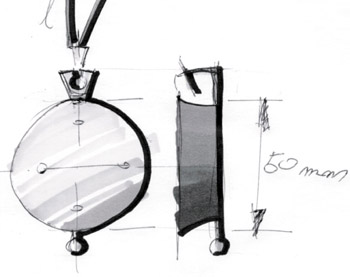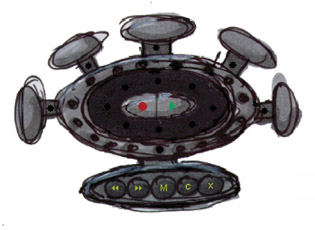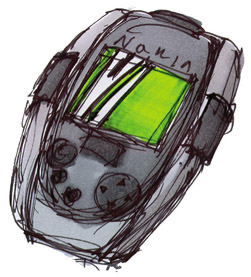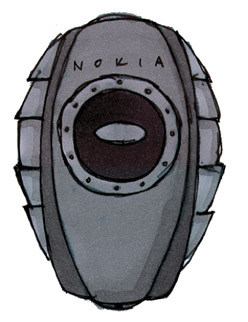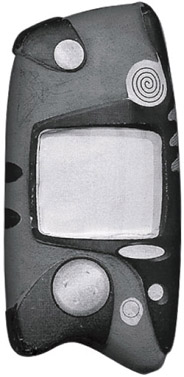Think by Doing
|
|
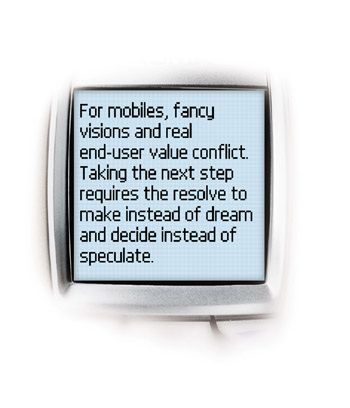
The importance of products fulfilling real user needs is repeated over and over again, but the mobile world around us is not constructed on practical needs alone. Solutions can be explained after their success to fulfill some need when, very likely, without the introduction of the designs themselves, the depth or even the existence of those needs would have never manifested itself. Consider the contemporary mobile content services as an example—what is selling is downloadable ringing tones and screen logos. The practical utility of these services is close to nonexistent, yet consumers use them, and some people have made their living producing them. Without having seen this firsthand, few of us would have believed that such a business could exist.
| | Hand-drawn sketch Project team: “This is cool. I’d like to have one. The users will love it.” Users: “This is boring.” |
| | PC simulation I The review board: “We want something more Nokia-like.” |
| | PC simulation II Every designer: “Oh no, The beautiful simplicity of the initial concept is gone” Project manager: “Let’s try to add more fun to the previous one. Could you try to make games without a display.” |
| | PC simulation III Designer: “I like this, the users probably won’t.” Project manager: “Nah, we can’t do decent games without a display.” |
| | Hardware prototype to the board: “That’s too close to basic phones. Let’s kill the project and make a phone feature out of your concept.” |
Future mobile services promise wild possibilities. They are not yet concrete, but they point the way in promising directions. There is a strong will and commitment to a mobile information society. However, taking the next step to introduce a new service that is truly discontinuous with present technology is the headache. It would be very convenient to launch it based on a set of hard-core practical needs. The examples in this book about mobile service studies underline this point; personally relevant services that save time and trouble are a reliable basis on which to design new technologies.
The foreground of mobile interfaces is likewise full of possibilities: adaptability and intelligent user interfaces, virtual communities and sharing, emotional interaction, and all other emerging technologies. The vision is there, but what is the first adaptable feature that really adds value to the end user?
The Nokia user interface development culture appreciates down-to-earth thinking. In many business units at Nokia, aversion to hype is almost tangible. Fancy, exploratory projects without links to known technology changes or user needs have been few and far between. We hope that examples in Part 3 have given readers some idea about the concrete and near-term objectives of the preponderance of projects. They reflect the passion for doing instead of dreaming, for business thinking over academic thinking, and for deciding over explaining.
Research and concept design aim at the straightforward concretization of ideas. Much of the thinking takes place through doing. A range of prototyping techniques and research approaches are in use. Different kinds of problems are approached by designing and evaluating different UI simulations: e.g., paper prototypes for menu navigation and hardware simulations for text entry and dual-task problems. Research and design methods are seldom applied by the book. The real objective is to get something to work. If we learn why it works, that is a by-product—and an extremely welcome one at that.
The “rough and dirty” approaches have been mentioned a couple of times in this book. Some of those projects have turned out to be relatively large and time-consuming, however. The notion of “rough and dirty” needs to be understood as referring to the attitude of focusing on the essential rather than actually running through projects as superficially as possible. Arranging global tests, prolonged testing with prototypes for learning curves, arranging dual-task situations, and creating mobile services all require a lot of work and expertise. Subjects may tolerate prototypes for only a short while.
There is also a level of usability decision making which occurs when there is no time for user studies. Innovative technologies come from somewhere else than user needs in such cases, but there may still be valid reasons for incorporating them into products. The usability experts need to work for the best possible match in every circumstance, no matter how averse. Ultimately the organization must trust in the expertise of the team and the competence of its individual members.
“Doing,” that is, working with prototypes, becomes increasingly challenging. Novel services require field testing. The equipment must be functional, portable, and suitable for field use. Several prototypes must be manufactured so that they can communicate realistically. Packing technology into a fieldproof form at the prototype phase is substantially more difficult than building simulations intended for demonstration and laboratory test use.
|
|
EAN: 2147483647
Pages: 142
- Chapter I e-Search: A Conceptual Framework of Online Consumer Behavior
- Chapter VII Objective and Perceived Complexity and Their Impacts on Internet Communication
- Chapter IX Extrinsic Plus Intrinsic Human Factors Influencing the Web Usage
- Chapter XII Web Design and E-Commerce
- Chapter XV Customer Trust in Online Commerce
